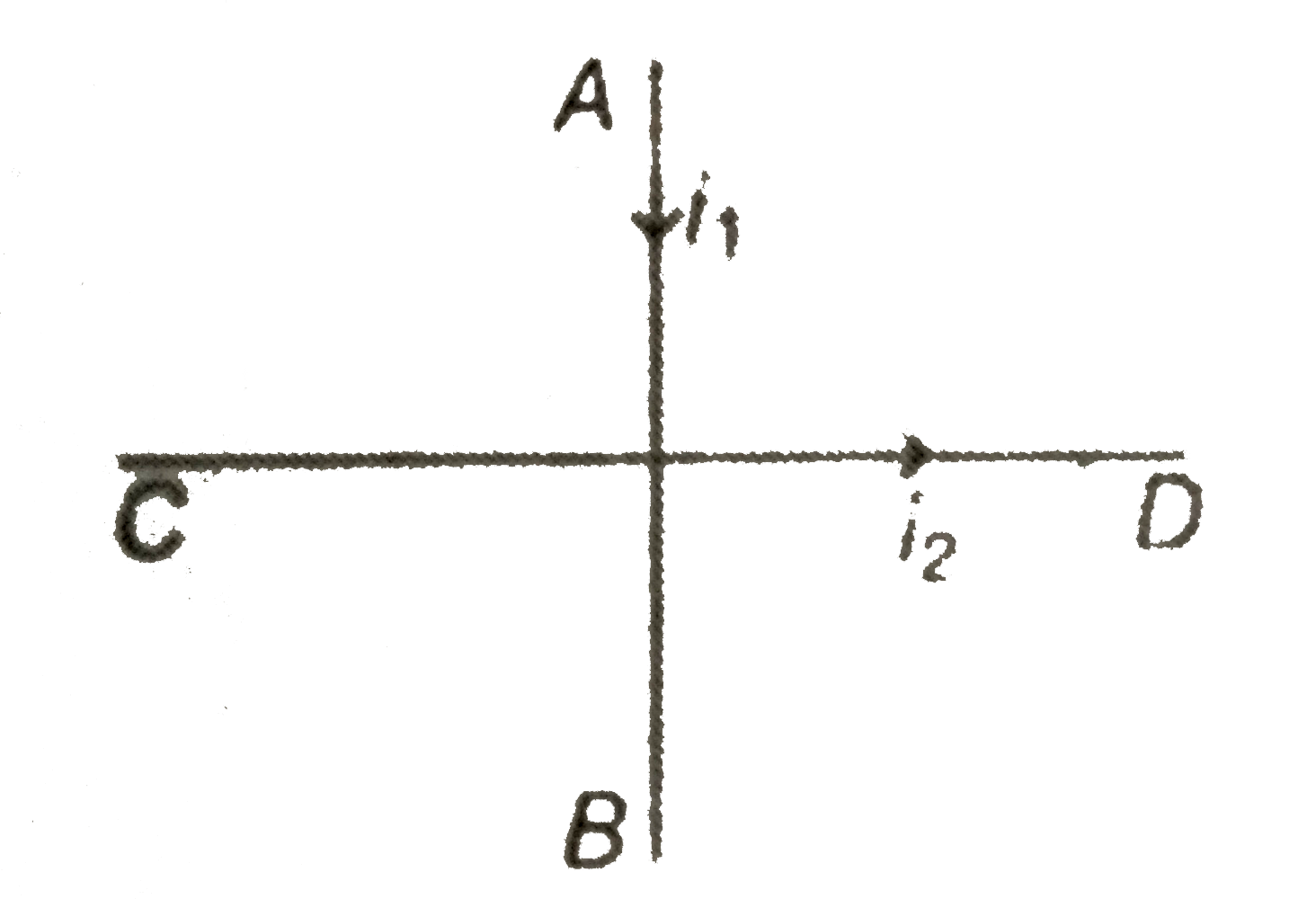Two parallel, long wires carry currents i1andi2 with i1>i2. When the currents are in the same direction, the magnetic field at a point midway between the wires is 10mu T. If the direction of i2 is reversed, the field becomes 30mu T . The rationi1i2 is
4
3
2
1
The correct Answer is:C
To solve the problem, we will follow a systematic approach to find the ratio I1I2.
Step 1: Understanding the Magnetic Field due to Long Parallel Wires
When two long parallel wires carry currents I1 and I2, the magnetic field at a point between them can be calculated using the formula:
B=μ02πdI
where μ0 is the permeability of free space, d is the distance from the wire to the point of interest, and I is the current in the wire.
Step 2: Magnetic Field When Currents are in the Same Direction
Given that the currents I1 and I2 are in the same direction, the magnetic fields at the midpoint between the two wires will be:
- B1 due to wire 1 (downward)
- B2 due to wire 2 (upward)
Since I1>I2, we can express the net magnetic field B at the midpoint as:
B=B1−B2=μ02πdI1−μ02πdI2
This simplifies to:
B=μ02πd(I1−I2)
According to the problem, this magnetic field is given as 10μT:
μ02πd(I1−I2)=10μT(Equation 1)
Step 3: Magnetic Field When the Direction of I2 is Reversed
When the direction of I2 is reversed, both currents now flow in the same direction (downward). The magnetic fields will both be downward:
B=B1+B2=μ02πdI1+μ02πdI2
This simplifies to:
B=μ02πd(I1+I2)
According to the problem, this magnetic field is given as 30μT:
μ02πd(I1+I2)=30μT(Equation 2)
Step 4: Forming a Ratio from the Two Equations
Now we have two equations:
1. μ02πd(I1−I2)=10
2. μ02πd(I1+I2)=30
We can divide Equation 1 by Equation 2:
1030=I1−I2I1+I2
This simplifies to:
13=I1−I2I1+I2
Step 5: Cross-Multiplying to Solve for I1 and I2
Cross-multiplying gives:
I1+I2=3(I1−I2)
Expanding this:
I1+I2=3I1−3I2
Rearranging terms:
I1+I2+3I2=3I1
This simplifies to:
4I2=2I1
Step 6: Finding the Ratio I1I2
Now, dividing both sides by 2I2:
I1I2=42=2
Conclusion
Thus, the ratio I1I2 is:
2
B=μ02πdI
where μ0 is the permeability of free space, d is the distance from the wire to the point of interest, and I is the current in the wire.
- B1 due to wire 1 (downward)
- B2 due to wire 2 (upward)
B=B1−B2=μ02πdI1−μ02πdI2
This simplifies to:
B=μ02πd(I1−I2)
According to the problem, this magnetic field is given as 10μT:
μ02πd(I1−I2)=10μT(Equation 1)
B=B1+B2=μ02πdI1+μ02πdI2
This simplifies to:
B=μ02πd(I1+I2)
According to the problem, this magnetic field is given as 30μT:
μ02πd(I1+I2)=30μT(Equation 2)
1. μ02πd(I1−I2)=10
2. μ02πd(I1+I2)=30
1030=I1−I2I1+I2
This simplifies to:
13=I1−I2I1+I2
I1+I2=3(I1−I2)
Expanding this:
I1+I2=3I1−3I2
Rearranging terms:
I1+I2+3I2=3I1
This simplifies to:
4I2=2I1
I1I2=42=2
2
Topper's Solved these Questions
- MAGNETIC FIELD DUE TO CURRENTBook:HC VERMA ENGLISHChapter:MAGNETIC FIELD DUE TO CURRENTExercise:Objective 2
Explore 7 Videos
- MAGNETIC FIELD DUE TO CURRENTBook:HC VERMA ENGLISHChapter:MAGNETIC FIELD DUE TO CURRENTExercise:exercise
Explore 60 Videos
- MAGNETIC FIELD DUE TO CURRENTBook:HC VERMA ENGLISHChapter:MAGNETIC FIELD DUE TO CURRENTExercise:worked out examples
Explore 15 Videos
- MAGNETIC FIELDBook:HC VERMA ENGLISHChapter:MAGNETIC FIELDExercise:objective2
Explore 9 Videos
- MAGNETIC PROPERTIES OF MATTERBook:HC VERMA ENGLISHChapter:MAGNETIC PROPERTIES OF MATTERExercise:Short Answer
Explore 6 Videos
Similar Questions
Two parallel, long wires carry current i1 and i2 withi1>i2. When the currents are in the same direction, the magnetic field at a point midway between the wires is 30μT. If the direction of i1 is reversed , the field becomes 90μT. The ratio i1/i2 is
View SolutionTwo parallel, long wires carry currents i1andi2 with i1>i2. When the currents are in the same direction, the magnetic field at a point midway between the wires is 10 μT. If the direction of i2 is reversed, the field becomes 30 μT. Find the ratio i1i2.
View SolutionTwo parallel long wire carry currents i1 and i2 with i1>i2 . When the currents are in the same direction , the magnetic field midway between the wires is 10μT . When the direction of i2 is reversed, it becomes 40μT . The ratio i1/i2 is
View SolutionTwo parallel long wires carry currents i1andi2 with i1>i2.When the currents are in the same direction then the magnetic field midway between the wires is 10μT. when the direction of i2 is reversed ,then it becomes 40μT. then ratio of i1/i2 is
View SolutionTwo long parallel wires carry currents i1 and i2 such that i1>i2. When the currents are in the same direction, the magnetic field at a point midway between the wires is 6×10−6T. If the direction of i2 is reversed, the field becomes 3×10−5T. The ratio i1i2 is
View SolutionTwo long parallel straight conductors carry current i1 and i2(i1>i2). When the currents are in the same directions, the magnetic field at a point midway between the wires is 20μT. If the direction of i2 is reversed, the field becomes 50μT. The ratio of the current i1/i2 is :
View SolutionTwo parallel long wires carry currents 18A and 3A. When the currents are in the same direction, the magnetic field at a point midway between the wire is B1. If the direction of i2 is reversed, the field becomes B2. Then the value of B1/B2 is
View SolutionTwo parallel wires carrying equal currents i1 and i2 with i1>i2. When the current are in the same direction, the 10mT. If the direction of i2 is reversed, the field becomes 30mT. The ratio i1/i2 is
View SolutionThe two long, straight wires carrying electric currents in opposite directions. The separation between the wires is 5.0 cm. Find the magnetic field at a point P midway between the wires.
View SolutionTwo long wire AB abd CD carry currents i1 and i2 in the direactions show in figure

View Solution
